Or, in less colorful and less 'Travis McGee' terms: Autumn, Winter and Spring (all of which are lonely and rainy) are passing. We now face the prospect of dry, hot days which bring dehydration and sunburn -- as difficult as it may be to imagine, for those of us who are familiar with the rainy climate in Oregon. Will Geer said, in "Jeremiah Johnson":
March is a wet and muddy month. Some folks like it. Farmers, mostly.IPSC shooters don't have much truck with March. Also, November, December, January and February. April Showers are oppressive in Oregon, and even May and June can bring surprisingly fierce downpours in a minute-by-minute changing environment. There's a saying here: "If you don't like the weather ... wait five minutes".
However, Saturday (May 14, 2005) fooled the weathermen (no great challenge to the weather; magnificent challenge to the weathermen) and instead of the predicted 'occasional showers' we saw the sun!
My ex-best-friend, who married my ex-wife, claimed "I once spent an entire summer in Oregon. It was one of the most pleasant weeks in my life." Well, he's from California; he's inclined to treat an actual CLIMATE with disdain. I feel the same way about San Francisco.
Still, we had a scheduled match and we came dressed for cold and rain. What we got was sun and heat, albeit high humidity. Reminded me in some ways of Alabama in the summer, except the air didn't quite taste like wet cotton, the soil wasn't red clay, and there was so much GREEN in every background that it fair took your breath away.
In May, the Irish envy us our Emerald Valley.
And they can't have all the shooting of pistols that we do.
The Albany Rifle & Pistol Club has one of the finest IPSC ranges in the world, and it was revealed to us as the gossamer background to a 10-stage, 250+ round match which challenged us to shoot & scoot at every opportunity ... and there were many opportunities in the Mac McCarter-designed match for the would-be Hoser in each of us.
One representative stage was the "Zig Zag". Run a PacMan-looking course from one close up and personal 6-round array to the next, and finish up on the tough but delightful Texas Star target.
Here's what it looks like at the start:
Al @ STAND BY

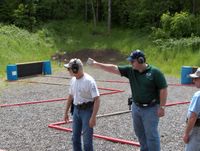
I took a lot of pictures on this stage, and I hope they don't load too slowly for those of us who are viewing through the narrow bottleneck of a modem. (Click on the pictures to see them in large format.) This picture shows the lush green background which is typical of ALL of the stages at ARPC, and also reveals why the stage is named "Zig Zag".
Here's what it looks like at the first turn:
Al running the Zig Zag


The competitor (Al, who REALLY doesn't like a full-face photo but consented to being photographed, as have all those who are depicted here) has engaged three IPSC targets behind hard-cover and is charging hard for the next shooting position.
Big Dog can MOVE!

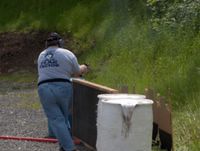
Changing from Al to "Big Dog", we see him cross-stepping as he engages the 3rd and final target on the second array. He's leaning into the turn, but stupidly I stopped the motor-driven camera after 3 exposures ... the last exposure would have shown him moving toward the third array but picking up the last shot one-handed as he pushed off from his strong foot. Another great moment in IPSC Action pictures lost because the photographer failed to sense the balance between position and momentum.
The "Groin-Pull Run"

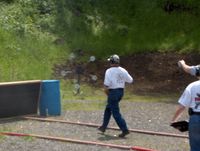
Moving from the 2nd to the 3rd array, we see yet another competitor in action. Bob is concerned with the possibility that one of his spare magazines might be dislodged by the bouncing action of a full-speed run, so he's protecting them with his weak hand. It looks awkward, perhaps, but Bob fulfilled the requirement that belt-carried equipment be retained during moments of strenuous, even violent activity.
Whatever works to get you through the stage. Note that no groin muscles were pulled during filming of this stage.
Mark on the Star

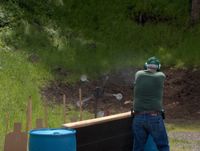
Still another competitor, "Mark II", is engaging the Texas Star target. This consists of five 8" steel plates mounted in a pentagram arrangements, the arms of which pivot on a bearing race.
Here's a better picture of the Texas Star:
Star!


Oops! Sorry, wrong sport (Tennis), wrong star (Anna Kournakova). Even wrong state (Russia). Certainly not a target. (Note: the link is heavy broadband)
But you get the idea ... a lot of points of interest going on, hard to keep track of what's moving where.
Let's try again:
target?

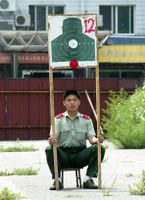
Mmmmm ... no. Wrong state (China), the only stars are on his epaulets. And it's showing people where it should show targets. Well, that's something for China to work out.
I can't find a still photo of a Texas Star in my library. You'll have to be content with the photo without a large-format option, but it gives you a sense of the size of the target. (Note: the guy holding the target is not an optional accessory. He's Terry Ashton, the wicked man who invented the target.)
You can see a video of somebody shooting the Texas Star here. (Thanx to KR Training for the link; look under "2001" and "Shooting the Texas Star MPEG MOVIE". It takes about 3 minutes to download using a 56 baud modem.)
While we're waiting for this (and Anna's!) movie to download, let's go back to Albany and see the other photos I've provide here.
We left Mark blasting moving steel targets. That completes the series of photos for the Zig Zag stage, but here are a couple of other interesting photos, and a little bit more about another stage in the match.
Brassing


One if the important functions of most IPSC matches is "Brassing". That is, recovering the expended brass which has been left on the ground after an IPSC competitor has completed a stage. Practical Pistol ("IPSC") competition can be an expensive hobby. Most participants seek to minimize the expense of competing by reloading their own ammunition. In fact, some 'wildcat' cartridges (and I specifically include the .38 Super, .38 Super Comp, and "Major Nine" ... 9x19 loaded to Major Power factor) are not commercially available, or at least not in a load suitable for making the compensator of an Open Gun work to maximum efficiency. Thus you will see, at most IPSC matches, grown men looking like chickens in a farmyard. The bobbing and pecking motions become stylized: anyone who is self-conscious about their dignity is advised to buy new brass after each match.
I know for a fact that some ladies (of course, I don't include SWMBO in this category) have on their computer a personal file folder consisting only of grown men stooping to retrieve brass. I believe these photographs are designated "Butt Shots". Probably, these ladies are amazed at the diligence by which men are willing to stoop to save a penny.
The RO:
"Mr. IPSC"

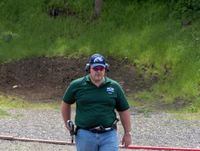
No dissertation on IPSC competition is complete without including a paen to the Range Officer. These volunteers, stalwart and steely eyed, labor each weekend to ensure that IPSC competition is conducted under conditions of the maximum safety. While they are tasked at ensuring that the competitor has an enjoyable shoot-the-cardboard experience, they must also be knowledgeable about the rules of competition and be willing to sacrifice their meager rest-periods between shooters for the greater good of us all.
Such a Range Officer is "Norm". He has, as has every RO, spent at least one weekend for special training (provided by the NROI) to teach and then test, finally to certify, his ability to fairly and objectively evaluate the performance of every IPSC competitor. He accepts his responsibility to 'make the hard calls' .
I offer this photo only to exemplilfy the steely eyed stalwartness which goes into the making of an RO. I believe Troy M. was his NROI trainer: Acolades to Troy, and to all USPSA Instructors.
Steely eyedness is not the sole purvue of Range Officers. Many competitors are RO's, and they maintain their steely eyes even when they function as competitors rather than as Range Officers. One good example is "The Fish":
Fish @ LAMR


Finally, we move completely off the ZIG ZAG stage to show yet another shooting challenge:
The "Tightrope" stage. (No, I have no idea where the stage name came from.)
Norm on "tightrope"

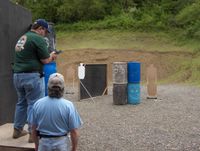
It's difficult to see the plethora of a target-rich environment, but the concentration of the competitor (Norm) and the volunteerism-generated dedication of the Range Officer (Fish) are obvious.
Most of the stages in this Level I match were about 24 rounds. This one required 22 rounds, forcing competitors in every division to carefully hoard rounds and to know when and where to change magazines ... which may range from 7 to 27 rounds in their magazine. There was at least one user of a 6-round revolver, which was even more challenging.
IPSC competition offers unique challenges for every competitor. It can be expensive, although it is similarly possible to compete using minimally expensive equipment. Why do these men and women do it?
It's fun. You get to get outside and play silly games with your friends. You can make rude noises and noxious odors shooting pistols (note: do NOt brass behind The Geek or O'Shea, as they have historically exuded noxious odors not directly connected with their choice of gunpowder, when Brassing.)
If your name is Troy, or Will, you may have been a casual observer at this IPSC match. We were glad to see you, we're happy that you came by to watch us play, and we hope that you come back with a pistol and a couple of hundred rounds of ammunition to join us at play.
If you are neither of these people, perhaps you will be a guest at a future match and are equally receptive to our enthusiasm and our willingness to accept new members in USPSA competition.
When you've found a fun game to play, you want EVERYONE to join you here in the bright sunshine to enjoy shooting, to make new friends, and to enjoy their company. Being competitive is important in that it adds to the richness of the experience; we want to be compete because it adds richness to the experience. We are not competing primarily because we all think we can beat everyone who shows up at the match.
It's a GAME, Folks!
(UPDATE: May 16, 2005)
Corrected typos and awkward sentence structures. Added some links.
No comments:
Post a Comment